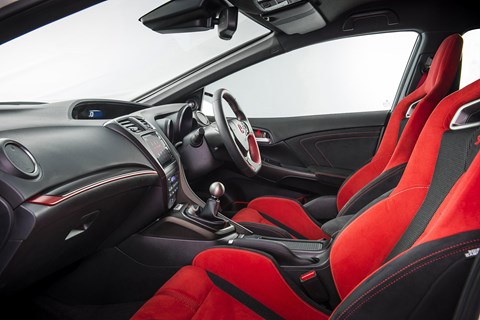► Read our six-month test of a Civic Type R
► Optioned with GT Trim and pearlescent paint
► Invisible to police radar? We better hope so…
Final report on our 2016 Honda Civic Type R: a very particular Type of addiction
After 8000 hard-driven miles, numerous three-figure strops through epic Welsh driving roads, midnight tussles with other hot hatches and hundreds of gratuitous throttle blipping downchanges through one of the sweetest manual ’boxes on sale, we finally made sense of the Civic in stationary traffic on the side of a dual carriageway in Northamptonshire.
We’d declared the Type R (FK2 in fanboy speak) a winner in an early giant test against a Golf GTI, but still we had our reservations. We’d wondered about the OTT styling and the new engine that traded personality for power. Our long-term fleet also included a Golf R, and since first driving the Civic, the brilliant Focus RS has arrived in showrooms. We strongly suspected that’s where our money would go.
But that’s us. Today in the queue for Silverstone circuit among kindred spirits, sitting cheek-by-jowl with modified previous generation Civics, Imprezas and Evos, the occupants of each giving the Civic the thumbs up, a nod, or at least a look of recognition, of respect, you could genuinely see that a certain section of the car community wouldn’t dream of buying the capable but tediously demure Golf R over one of these. And that’s presuming that a 25-year old could rustle up £32k for either, plus a good chunk of it again for insurance.

It’s enough to make me want to roll down the window and bump some fists across the queue, but I better not. The mellifluous tones of CSN’s Judy Blues Eyes emanating from our Type R’s speakers will give the game away that I’m only a pretender here. I need Radio 1 Xtra but, six months in, I can still barely remember how to use the unintuitive aftermarket-style infotainment system.
The ‘here’ in question is a giant celebration of Japanese car culture based at Silverstone circuit. Going by a name so un-pc it ought to be sponsored by UKIP, Japfest (I dread to think what they’ll call the Chinese carfest in 2040 once Geely and Great Wall’s cars have finally broken into Europe and our subconscious) is simply huge. If you’ve been to watch a big name football side play you’ll know what I’m talking about when I describe the sight of a sea of cars unfolding before me as I crest the bridge to enter the area inside Silverstone’s track. There are 3000 vehicles on display this weekend and more than 15,000 visitors will pay to see them. A few kids hanging around in a field, this is not.

We’ve come to Japfest to say sayonara to our Civic Type R, which came to us fresh from repeated beatings as a general press car, and has been treated with no more respect since then. More radically re-engineered than any previous Civic R, the latest version’s big news was a swap from naturally aspirated power to the turbocharged sort. That meant losing the banzai sprint to a heady 8200rpm rev limit that characterised previous Rs and forgoing the screaming soundtrack that went with it. What you got in return was a 50% boost in power to 306bhp, while torque doubled from a supermini-like 143lb ft to a serious 295lb ft.
Of course, half the car fans here are probably claiming similar results from that £50 air filter they fitted last weekend, but the key thing about the latest Type R isn’t necessarily the extra push on offer, but how much more usable the performance is. For the first time on a hot Civic the middle of the rev range isn’t like waiting through an ad break for tonight’s ITV action movie to come back on. Changing gear has become optional, but still definitely desirable. There’s no dual-clutch transmission available and the six-speed manual shift quality is so good we can’t imagine anyone ever yearning for paddles.

There are a couple of other new-shape Type Rs at the show, and one imagine-if Civic wagon kitted out by Synchro Motorsport in full Type R regalia. But they’re needles in haystacks compared with some of the other models here. Line after line of Mitsubishi Evos, Imprezas and Civics dominate the displays. Each, of course, is its owner’s pride and joy – yes, even the awful first-gen Micra and rusty MX-5s – but as a punter it can make navigating the show quite hard work. It’s pretty clear that Japfest isn’t just made possible by the UK’s numerous car clubs. It’s made for them too.
I can find a tidy Scooby sick, banging, wicked, awesome or whatever the current in-vogue word might be for the Japfest demographic, but I’m initially disappointed not to see more older obscure cars, stuff from the 1960s and 1970s and 1980s. Take time to search through the obvious cars though, and there are some brilliant curios and forgotten heroes. There’s a gullwing door Toyota Sera, a pretty little Datsun 180B SSS coupe, Nissan Cherry Europe (the Alfa Arna’s alter-ego), incredibly rare NSX Type R, and what certainly looks like an original early ’70s KPGC10 Skyline GT-R.
Not far away, an elderly couple snooze in their Subaru SVX oblivious to the occasional whiff of weed emanating from the cigarettes of their fellow showgoers watching the insane high-speed pro-drifting display.

But what is it about Japanese cars in particular that holds such an appeal? ‘If you want a fast, sensible car that ticks all the boxes you’d go for a German car,’ says Mark Riccioni, a feature writer for Max Power in its heyday, and now a freelance for photographer working for magazines with far smaller nipple counts, including CAR. ‘But there’s something of the underdog about Japanese cars, and the tuning culture around them is wilder and more relaxed than it is for European cars. Plus you’ve got the influence of driving games like Gran Turismo and Need for Speed introducing young people to both the cars and tuning firms like Spoon and HKS.’
But there are some older faces in the crowds too, besides mine, including Ed Green and his wife in their evil-looking previous-gen Type R. As CTR fans I expect them to express disappointment at the latest car’s lower rev limit and switch to turbo power, but they’re all for the new direction. The turbocharged engine means not only more power as standard, but makes it far simpler and cheaper to extract even more later on. And they love the more aggressive styling, too.

Richard Monk has just taken delivery of his new Type R and has already begun a journey that will likely see him throw thousands of pounds at a car that we don’t think wants for much out of the box. But for people like Richard, modifying is in the blood, and even if the numbers don’t stack up when it comes to selling up sometime down the road, they’ll have created and enjoyed living with a car that has their personal stamp on it.
In fact our Civic stands out for being one of the very few unmodified cars at Japfest, but it’s so complete out of the box, there really is little need to mess with it. It’s also a fairly easy car to live with, given the brief. Yes, the ride is tough and road noise isolation poor, but besides its monster pace and monstrous looks, the Type R is genuinely practical too, offering a huge boot and cheap servicing. But above all, it’s a genuinely exciting car. Five years from now when depreciation has taken the sting out of the £32k list price, Japfest is going to be crawling with them.
Modding your Type R
Turning up to Japfest in a showroom-stock car, even one as lairy as the Type R, is like turning up to a black-tie event in a wife beater and espadrilles. Suppose we could mod our Type R in time for next year’s event, here’s how it might go: First, a Milltek exhaust, or maybe a Remus with its remote control volume control, from around £1240. That, plus a large capacity Forge Motorsport intercooler (£621) will make the most of the obligatory remap: AmD promises to boost power from 316bhp to between 370-400bhp for a bargain £500.
KW’s £1600 V3 coilover suspension kit claims to save time on a run round the Nordschleife and, to ensure it looks fast even when parked on display, consider a dusting of Mugen: fixed bucket seats at £5254 the pair and £1580 of high-level rear wing. Total cost: £10,795, excluding fitting and psychiatrist’s bills.

Count the cost
Cost new £32,820 (including £525 of options)
Dealer sale price £25,907
Private sale price £24,472
Part-exchange price £23,392
Cost per mile 10p
Cost per mile including depreciation 78p
Logbook: Honda Civic Type R
Engine 1996cc 16v turbo 4-cyl, 306bhp @ 6500rpm, 295lb ft @ 2500rpm
Transmission 6-speed manual, fwd
Stats 5.7sec 0-62mph, 168mph, 170g/km CO2
Price £32,295 As tested £32,820
Miles this month 1394
Total miles 13,750
Our mpg 29.1
Official mpg 38.7
Fuel cost overall £1322.74
Extra costs £0
By Chris Chilton
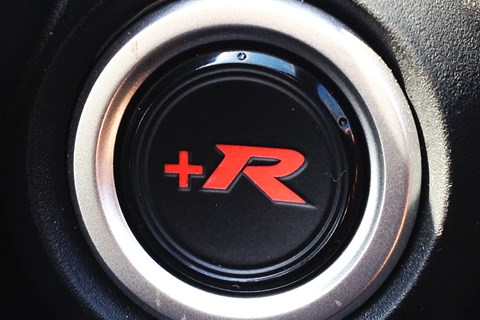
Month 5 running a 2016 Honda Civic Type R: steer clear of the +R mode
The Type R is rapidly heading (in every sense) towards 13,000 miles, but few of the 8k we’ve done have been with the little button above depressed.
Almost hidden on the right of the dash behind the steering wheel, the +R button takes a grinding wheel to the throttle response and turns the lighting on the triple gauge cluster a menacing red.
But it also adds unnecessary heft to the steering and crucifies the composure, making the Civic actually less fun on the road. We’re enjoying the Type R just fine without it.
Logbook: Honda Civic Type R
Engine 1996cc 16v turbo, 306bhp @ 6500rpm, 295lb ft @ 2500rpm
Transmission 6-speed man, fwd
Stats 5.7sec 0-62mph, 168mph, 170g/km CO2
Price £32,295
As tested £32,820
Miles this month 948
Total 12,356
Our mpg 29.4
Official mpg 38.7
Fuel £156.61
Extra costs £0
By Chris Chilton
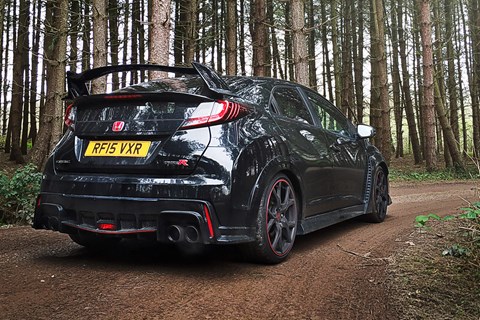
Month 4 running a 2016 Honda Civic Type R: we always hurt the ones we love
I love it. I hate it. I adore it. I despise it. One minute I want to rush back home and lavish Meguiars wax over every inch of the Civic’s nasty plastic bodykit. The next I want to rush home and put the same kind of distance between me and the Civic that we collectively put between us and that wimpy Cooper S last night.
Life is never meh with the Civic Type R. Plonk me in that bucket seat in the middle of nowhere and I can’t get enough of the way it carves up A and B roads. I’ve grown quite fond of the turbo engine and accepting of the lag, stopped getting annoyed at the wayward wet-road torque steer and never get tired of the way the LSD sucks you into the apex of a corner. I’ll even forgive the lack of VTEC shriek because the six-speed manual gearbox is so much more fun than a dual-clutch would have been. The Type R makes a stab at the mundane stuff too. The boot is enormous and the back seats fold completely flat. And there’s huge lazyman punch in sixth from 80mph, making motorway journeys far less arduous than they were in the old R.
But still I’ll confess to occasionally wavering when I’ve got an errand to run and need to pick a car in which to do it. Sometimes I simply can’t be bothered with the Civic and its hard ride, incessant tyre roar, rubbish visibility and full body cast seats that make it impossible to turn around and attend to small children. Sometimes, when I know there’ll be no chance to exploit the Type R’s performance, I take our family’s old A4 wagon instead, and even five minutes down the road, I feel no regret.
The one thing we haven’t yet done is the one thing the Honda was made for. We haven’t yet taken the Type R on track, an oversight we’ll have remedied in time for next month’s report. Something tells me the Type R might score a slight points win over our 130bhp diesel Audi at Silverstone. But first we had to get it ready for a pasting by dealing with the service the car’s display panel said was needed.
Marshall Honda’s promise to get back to me about our Type R’s service indictor’s surprise appearance at only 8500 miles didn’t come with any timescale. Today would be good, I mused to myself. Tomorrow would be fine. Next Monday? That would be okay. But weeks later, with 11k on the clock, and no word from the service department I thought I’d better give them another call.
The service itself was a simple oil change and the service from Marshall on the day, excellent. I sat and waited with the car, was given use of an office and the Civic was returned looking absolutely immaculate. There was nothing else to report, apart from the front tyres, which were down to 2mm as I’d noted last month. The bill came to a reasonable £100. Silverstone, here we come.

From the driving seat
+ Massive turbo punch, reasonable economy
+ Brilliantly tactile six-speed ’box
+ Huge boot, shame it misses out on Honda’s Magic Seats
– Tyre roar makes long journeys wearing
– Poor visibility makes parking a pain
Logbook: Honda Civic Type R
Engine 1996cc 16v 4-cyl turbo, 306bhp @ 6500rpm, 295lb ft @ 2500rpm
Transmission 6-speed manual, front-wheel drive
Stats 5.7sec 0-62mph, 168mph, 170g/km, 38.7mpg
Price £32,295
As tested £32,820
Miles this month 1064
Total miles 11,408
Our mpg 29.2
Official mpg 38.7
Fuel this month £175.74
Extra costs £100 (service)
By Chris Chilton

Month 3 running a 2016 Honda Civic Type R: do they all use this much oil?
I’ve yet to drive Honda’s new hybrid-powered four-wheel-drive NSX (or even make peace with that so-wrong collection of words), but while I wait to find out whether it really is fat Elvis in a bionic jump suit, I wedged myself behind the wheel of the car it has to live up to for a feature in CAR’s sister mag Modern Classics. This original NSX (car 59, no less) makes around 30bhp less and would be wasted by our Type R in a straight line and across country. But it’s a beautifully uncomplicated machine with uncorrupted, unassisted steering. The best bit? That incredible VTEC V6: katana-sharp throttle response, a proper clean, hard-edged sports car soundtrack and an 8000rpm redline. For all its turbo punch, the Type R doesn’t have an answer for that.
In other news, a pixelated spanner symbol has appeared on one of the Type R’s 76 dashboard displays denoting it needs an oil change. Not since the halcyon days of the Mitsubishi Evo, which needed scheduled fettling five times a year at the rate we accrue miles, have we had to talk about servicing in a third long-term report, but our Civic had already been thoroughly beasted for 5500 miles as a press demo hack before we got behind the wheel. Since then, the hungry motor has already gobbled through a top-up of 5w20 oil and most of the front tyres. As soon as I get the chance I’m going to swap them with the rears to ‘equalise’ the wear (ie, sidestep a £300 bill).
By Chris Chilton
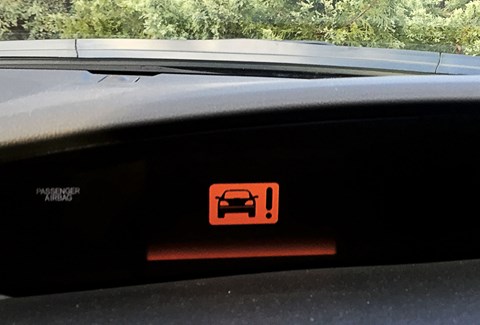
Month 2 running a Honda Civic Type R: how to spot the GT pack
It’s easy to tell an ordinary Type R from one fitted with the optional GT pack: the £2300 pricier car’s the one with red highlights on the front and rear splitters and a tendency to perform random emergency stops in the middle of the road.
The GT comes with a comprehensive suite of safety gadgets, and I’m absolutely a fan of the high-beam assist and traffic sign recognition. But the auto-braking collision avoidance device seems convinced that I’m determined to rear-end everyone, including the bush at the end of my drive.
By Chris Chilton
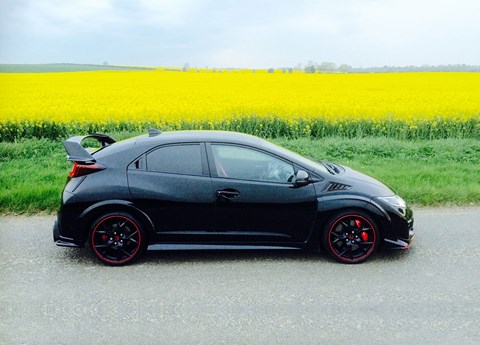
Diary update: a second opinion on our CTR
My first go in the Honda Civic Type R – and I came away pleasingly surprised. Where I was expecting thuggish road manners and a rock-hard ride, I found a remarkably rounded hot hatch.
Expectations were set by the stealth black paintwork with matching ebony alloys set off with scarlet rim-rings. That huge rear wing. All the aero addenda and air vents peppering the normally oh-so-sensible Civic bodyshell. I mean, just look at it. It’s a thug’s car, isn’t it?
Actually, no. When you look past the garish red seatbelts and concentrate on actually driving the thing, there’s polish aplenty. There’s little slack in the drivetrain and the R’s gearchange is a tactile delight, making it easy to pootle around town. And then you notice the ride, which is more absorbent than I was expecting, and the well-weighted, chunky steering lending a nimbleness hitherto unknown to Civickind.
It’s not quite a sheep in wolf’s clothing, but it certainly has a softer side, the Civic Type R. Stay tuned to see what it’s like on the ragged edge. Can the inner devil, the R’s dark side be woken on a cross-country blast? Our long-term test review is sure to find out…
By Tim Pollard

Month 1 running a Honda Civic Type R: the introduction to our long-term test
‘I’m bigger and bolder and rougher and tougher, in other words sucker there is no other.’ Even with the help of a product-planning crystal ball like Georg Kacher’s, it’s unlikely that ’90s Dutch hard house duo Human Resource had the latest 168mph Civic Type R in mind when they released 1991’s Dominator.
But given the unarguable Max Power connotations of the latest Type R’s theatrically overblown styling and the way the hot Civic has commanded the affordable performance car conversation of late, they seem like a good pairing. Right down to the Hoover sound effects.
This car is hardcore to look at and to drive. But what about to live with? That’s what we’ll be finding out over the next six months. We already know from last July’s Giant Test how good the Civic is to send down a Welsh B-road. But the fact that it comes with (and only with) five doors for the first time, and that the new turbocharged engine doesn’t just bring more power, but vastly improved flexibility, suggests this might be the most useable Type R yet.
Type Rs come in two flavours, the regular car for £29,995 on the road or the GT for £32,295. They’re all but identical from the outside, both coming with 19in alloys, deeply sculpted front seats and that gigantic rear spoiler plus keyless start, active city braking and a reversing camera.
But we went for the GT, judging the £2300 premium a fair exchange for the posher model’s 320W Garmin multimedia system, auto lights and wipers, dual-zone climate and parking sensors. On top of that there’s the peace of mind that comes from a suite of safety systems that includes blind-spot monitoring, forward collision warning and traffic-sign recognition.
The latter will ensure we’re never in any doubt how many multiples over the speed limit we’re going. This is a rapid machine, far quicker in the real world than suggested by the 5.7sec 0-62mph time, which would surely be in the fours were the Civic anything but front-wheel drive. That said, with the standard limited-slip diff marshaling the distribution of rations to the front tyres, traction is impressive given the power output, and the lack of torque steer commendable.
If only the styling was as controlled. It’s an aggressive-looking package, but not entirely well resolved. The way the 19in wheels fail to fill the arches is disappointing, and the weird overhang aft of the rear wheels looks plain odd. But beyond that there’s the inescapable feeling that it looks plain embarrassing. Maybe it’s the colour, a pearlescent black at £525, the only option fitted to our car. Black is one of only five hues available, and in theory, the least shouty, but the Championship White version I first drove last year would be my choice.
Whatever exterior colour you choose, you get the same slightly garish red-and-black interior trim, a theme that works better on the seats than the fat-rimmed wheel. The driving position, the seat support and the gearshift is excellent and a red R+ button behind the chunky wheel switches the instrument backlighting from saintly white to a devilish red while also sharpening the throttle response, tweaking the steering map and tightening the standard adaptive dampers by a significant 30%.
Will I be reaching for that button again and again, or just the headache pills and a niqab whenever we have to drive it in public? We’ll find out next month.
Logbook: Honda Civic Type R
Engine 1996cc 16v turbo, 306bhp @ 6500rpm, 295lb ft @ 2500rpm
Gearbox 6-speed manual, front-wheel drive
Stats 5.7sec 0-62mph, 168mph, 170g/km
Price £32,295
As tested £32,820
Our mpg 26.5
Official mpg 38.7
By Chris Chilton
Read CAR magazine’s Honda Civic Type R review here
